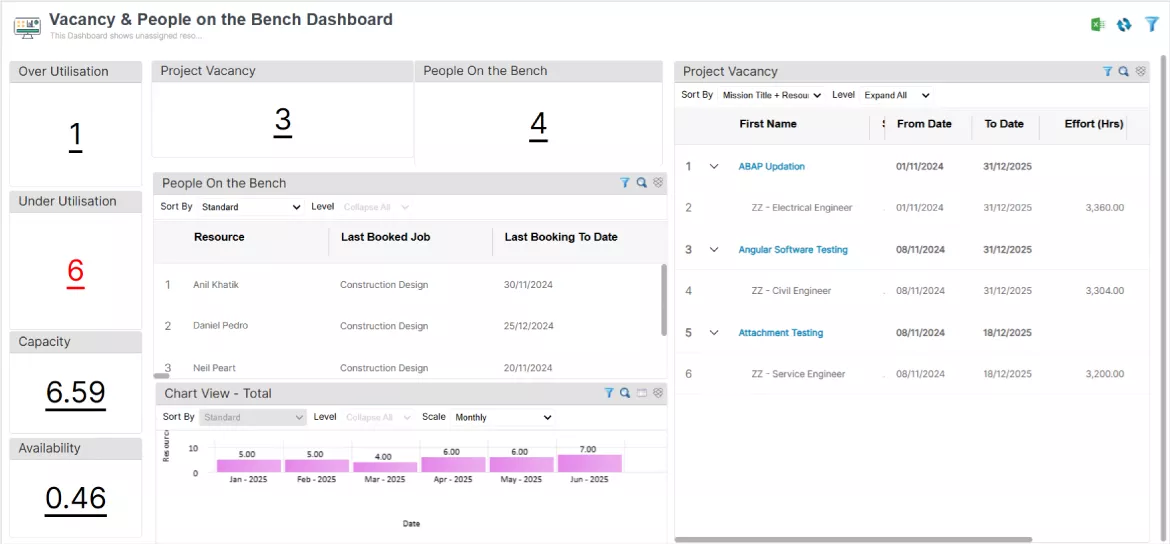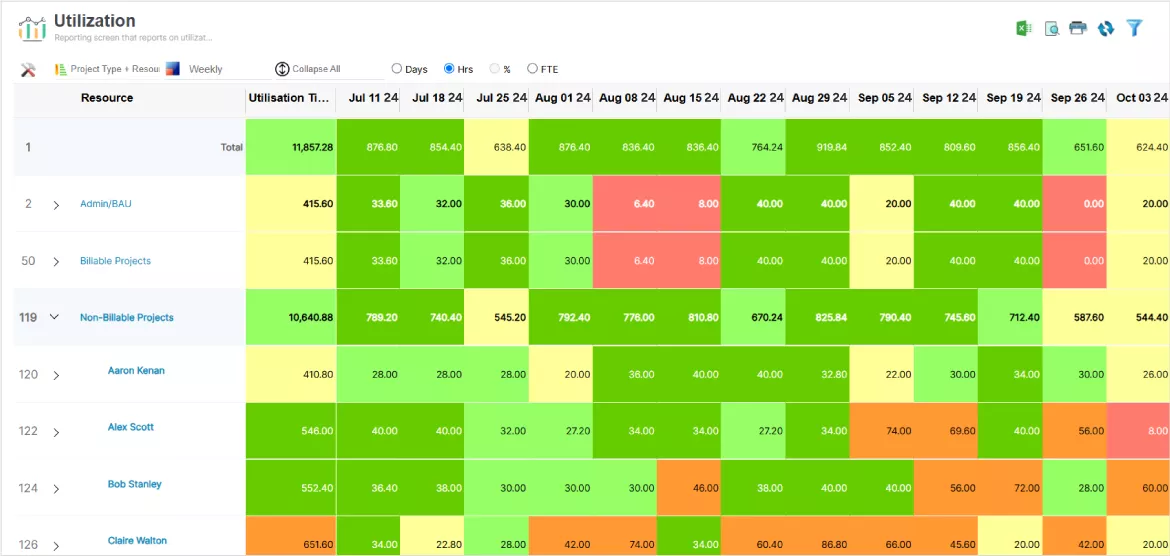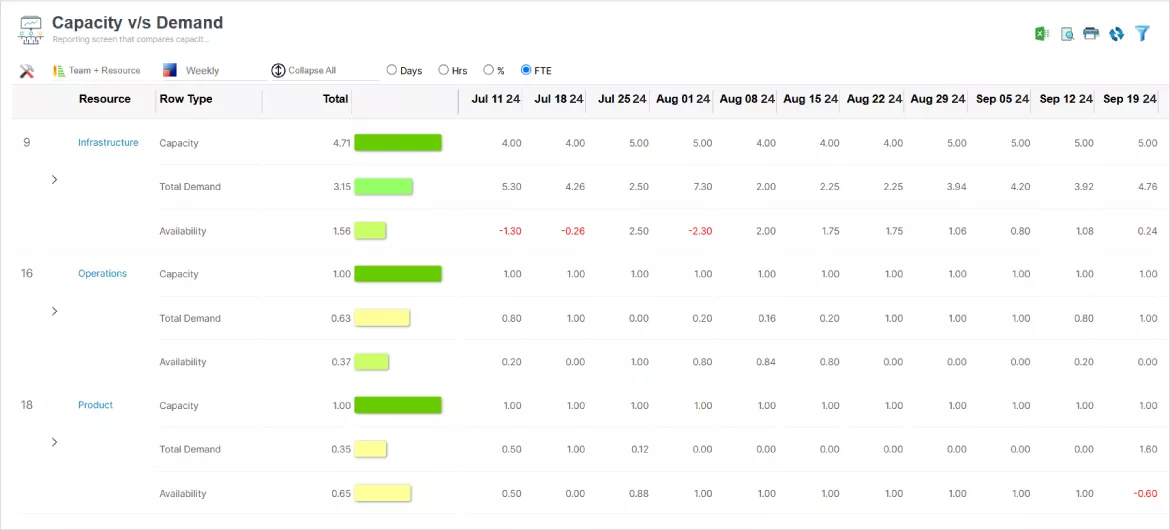In today’s highly volatile market, one of the biggest challenges for organizations is balancing resource supply with fluctuating demands. With unexpected economic shifts and evolving customer expectations, implementing capacity management practices becomes essential.
It enables companies to stay agile and resourceful, helping them thrive and outperform competitors. Additionally, it ensures that organizations remain productive and resilient, even in the face of unforeseen challenges. By strategically managing resource capacity, businesses can maximize efficiency and establish a sustainable framework for growth.
This blog will delve into the essentials of resource capacity management, its importance, and the strategies that will help you join the ranks of a well-managed business.
Let’s begin with the definition of capacity management.
What is Capacity Management?
Capacity management is a process that ensures an organization has the right mix of human and non-human resources to meet project and business goals efficiently. It involves forecasting project requirements, assessing existing capacity, identifying demand gaps, and taking corrective actions to secure the right resources ahead of time. Efficient capacity management enables businesses to remain agile and responsive in the face of changing market conditions.
In addition, it helps improve profitability by forecasting billable utilization levels and optimally leveraging existing resources.
If you’re often faced with questions like:
- Do we have sufficient resources to work on current and pipeline projects?
- Are there enough projects to deploy the available resources?
- Is there centralized visibility into the current resource capacity and demand?
- Is there an adequate budget to complete projects?
Then, efficient capacity management is what you need to prioritize to overcome these challenges.
Capacity Management Example
Consider a software development company managing several projects with varying deadlines and also has a new application development project in the pipeline.
To ensure effective IT capacity management, the manager conducts a resource assessment, evaluating the team’s skill sets and current workload. The goal is to determine if sufficient developers, designers, and testers are available to meet current and future project demands.
Upon reviewing the capacity data, the manager identifies a shortage of resources skilled in database management and SQL, critical for the new application project. In response, the manager reallocates developers who have completed their tasks on other projects, assigning them to the high-demand database roles. This proactive reallocation minimizes idle time, reduces the need for last-minute hiring, and ensures that the team remains aligned with project requirements.
As a result, the company maximizes resource utilization, minimizes delays, and improves overall profitability, efficiently adapting to fluctuating resource demands.
Next, let’s explore the types of capacity management.

Types of Capacity Management
Capacity management can be categorized into Workforce, Production, Strategic and Operational. Let’s understand each type in detail:
Workforce Capacity Management
Workforce capacity management involves analyzing current and future resource demand while assessing the workforce’s capacity, skills, competencies, and other attributes. In case of resource deficit or excess, managers can take proactive resourcing measures to ensure that the right talent is available to kickstart the project on time.
Production Capacity Management
Production capacity management assesses whether the firm has the required workforce, technology, facilities, etc., to meet current/upcoming production goals. This process considers factors like supply chain constraints, equipment maintenance, availability of raw materials, etc. In case of discrepancies, steps are taken to bridge the demand gaps, enhancing operational efficiency and overall output.
Strategic Capacity Management
Strategic capacity management is a long-term approach to aligning a firm’s resource capacity with upcoming demands to support its business goals. By proactively assessing the availability of people, facilities, finances, etc., managers gain enough lead time to eliminate resource-related issues before they impact projects, ensuring smooth delivery.
Operational Capacity Management
Operational capacity management refers to the day-to-day process of managing resources to ensure that operations run smoothly and efficiently. By focusing on real-time resource optimization and capacity adjustments, managers can meet arising project demands with ease. This results in seamless project workflows and improved ROI.
Now, let’s discuss the importance of capacity management.
Read more: What is Resource Capacity Planning? An Ultimate Guide for Every Project Manager
Importance of Capacity Management
Capacity management is a critical function for businesses of all sizes and industries, enabling them to meet resource demands efficiently. One of its primary benefits is ensuring an organization has adequate resources to meet current and pipeline project demands.
By proactively forecasting resource requirements, managers can bridge capacity gaps with suitable corrective measures such as adjusting project timelines, hiring contingent staff, upskilling existing employees, etc. This enables organizations to prepare for demand volatility with more precision, prevents last-minute hiring/firing cycles, minimizes wastage due to a large bench, and lowers cost overruns.
Capacity management also involves forecasting resource utilization ahead of time. It provides an opportunity to maximize the billable utilization of resources and generate better revenue. More importantly, it enables organizations to futureproof the workforce by helping them upgrade their skill sets and stay abreast of evolving technological and market trends.
In essence, robust capacity management strategies help firms operate efficiently, meet project requirements, and remain competitive.
Now, let’s examine the impact of ineffective capacity management.
Consequences of Poor Capacity Management on Business
Organizations often struggle to foresee pipeline project requirements or accurately anticipate whether they have the right type, quality, and quantity of resources within their skill repository. As a result, when project demands arise, managers frequently engage in last-minute firefighting to secure competent resources on time.
This may lead to the hiring of subpar individuals, increased resourcing costs, poor project outcomes, dissatisfied clients, etc. It is a classic example of reactive capacity management.
To avoid this, adopting a proactive capacity management approach is recommended. It involves forecasting resource needs well in advance, monitoring current resource availability, etc. This ensures the right talent can be assigned to the right task when the need arises, ensuring timely project delivery within a stipulated budget.
Now that the consequences of poor capacity management are clear let us understand some key capacity management KPIs.
5 Capacity Management Metrics You Should Track
Here are five critical metrics that provide valuable insights into your team’s capacity and help you take corrective measures well in advance.
Capacity vs. Demand
Capacity vs. demand is a critical metric that helps you identify the shortage or excess of resources against project demands. This insight allows resource managers to bridge the gap proactively and ensure project needs are consistently met.
People on the Bench
This metric refers to employees not currently assigned to billable work, either due to temporary gaps or project transitions. Proactive resource forecasting helps managers allocate resources efficiently, minimizing downtime and maximizing resource utilization.

SAVIOM’s advanced Capacity vs. Demand BI dashboard helps managers proactively reduce idle bench time and boost workforce productivity.
Project Vacancy
The project vacancy metric highlights unfulfilled roles or resource gaps in pipeline projects. It allows managers to mobilize resources from non-billable or BAU tasks to billable projects, optimizing employee productivity.
Resource Utilization
Resource utilization is a way to measure how effectively the resources are utilized against their available capacity. It helps you ensure uniform utilization of the workforce and keeps over or underutilization of resources in check.
Forecast vs. Actual Time
The forecast vs. actual time lets you compare the booked hours against the actual time spent by resources on specific project activities. It enables managers to assess project cost-effectiveness, identify discrepancies early, and prevent billing losses.
Read more: What is Resource Utilization? A Complete Guide to Improve Business Efficiency
Capacity Management Best Practices
Below are some proven strategies organizations can adopt to optimize their capacity management practices.
Use a Centralized Platform to Track Resource Competency
A centralized platform enables resource managers to stay up to date with the workforce’s competencies in real time. It helps them allocate the most suitable resources to projects based on skills, experience, qualifications, and availability.
Moreover, with enterprise-wide visibility, resource managers can identify opportunities for growth and development, as well as gaps in skills that may require training or external hiring. This way, with a centralized system, managers can plan for future projects, ensuring resources are deployed efficiently.
Foresee Pipeline Projects to Bridge Demand Gaps Proactively
Forecasting resource requirements for pipeline projects enables managers to analyze resource capacity vs. demand gaps and identify the excesses/shortages of the required skills in advance. In case of any variance, they can take measures to bridge the demand gap.
Some of these techniques are retraining or upskilling the existing employees or hiring a permanent or contingent workforce. These practices enable you to stay ahead of the curve, prevent costly last-minute hires, and eliminate future project bottlenecks.
Read More: What is Resource Forecasting? An Ultimate Guide for Project Managers
Monitor Forecasted vs. Actual Resource Utilization to Maximize Billability
Tracking forecast vs. actual resource utilization helps assess whether resources are being used as planned. This metric highlights instances of over/underutilization of resources, allowing for data-driven adjustments.
By comparing the two, managers can identify areas where resources are underperforming, potentially leading to missed billable hours. Conversely, overutilization can signal burnout risks. Thus, this practice ensures the efficient use of resources and helps keep billable hours at an optimal level.

SAVIOM’s robust Resource Utilization reports and color-coded heatmaps help forecast resource utilization levels with ease.
Streamline Resource Requisition Workflow for Timely Allocation
A structured resource requisition workflow begins with the project manager placing a request, specifying the roles and skills required for the project. The resource manager then reviews the request, searches for qualified talent, and proposes suitable candidates.
Following that, the project manager selects the resources that best match the project needs. This way, streamlining allocation through automated requisition workflow maintains an audit trail of requests, reduces manual errors, keeps stakeholders informed, and helps prevent resource scheduling conflicts.
Read More: What is Resource Allocation? A Comprehensive Guide for Project Success
Forecast Resource Bench Time to Take Corrective Measures
Forecasting bench time is essential for managing resources who are expected to hit the bench due to sudden ramp-down activities. A high number of benched resources leads to unnecessary overhead costs and reduced employee engagement.
By predicting when resources may go idle, managers can assign them to upcoming projects, maintaining high productivity and preventing revenue loss. For instance, managers can adjust project start dates or proactively plan training/shadowing opportunities for resources before they get rolled off.
Plan for Different Scenarios Using What-if Analysis
Balancing the resource capacity in a multi-project environment can be challenging. To overcome this, organizations can utilize what-if analysis to simulate and compare different scenarios and create best-fit resource capacity plans.
Through simulation & modeling techniques, managers can assess the impact of changes on metrics like utilization, availability, etc. This way, they can either extend timelines or reallocate resources to high-priority projects to overcome resource constraints.
Read More: What is Resource Planning, and Why is it Important in Project Management?
In the following section, let’s learn how modern capacity management software can help businesses streamline resource planning.
How Can Capacity Management Software Help?
Effectively managing resource capacity is essential for improving project outcomes and boosting profitability. Organizations can rely on SAVIOM’s robust capacity management software to improve business operations. Here is how it helps:
- The enterprise-wide visibility helps businesses track pipeline projects and current and future resource schedules.
- The tool’s multi-dimensional slice/dice capability matches resources to projects based on team, location, skills, roles, etc.
- With capacity vs. demand reports, managers can anticipate future needs, identify resource gaps, and address them proactively.

SAVIOM’s futuristic Capacity vs. Demand report helps managers anticipate & bridge demand gaps to eliminate last-minute resourcing chaos.
- An embedded competency matrix supports real-time tracking of resources’ skills and competencies, making it easier to combat skill gaps promptly.
- With real-time BI reports like forecast vs. actual, people on the bench, and project vacancy, managers can quickly gain insights into availability, utilization, and other essential metrics.
- Automated resource requisition workflows help streamline the process of resource requests while providing a clear audit trail.
- The what-if analysis feature further allows managers to simulate various scenarios and create optimal resource capacity plans.
These advanced functionalities of a capacity tracker allow businesses to manage resource capacity effectively, deliver high-quality projects, and enhance customer satisfaction.
Read More: How Scott Automation Redefined Resource Forecasting with SAVIOM
The Takeaway
Resource capacity management is the hallmark of organizational success and business sustainability. The above-mentioned best practices and the right capacity management tool will help minimize project risks while ensuring optimal workforce utilization. It will also enable businesses to achieve long-term success and growth.
Book a 60-day customized trial with SAVIOM today!
The Glossary
Read More: Glossary of Resource Workforce Planning, Scheduling and Management











